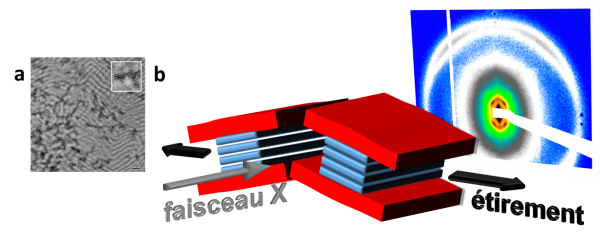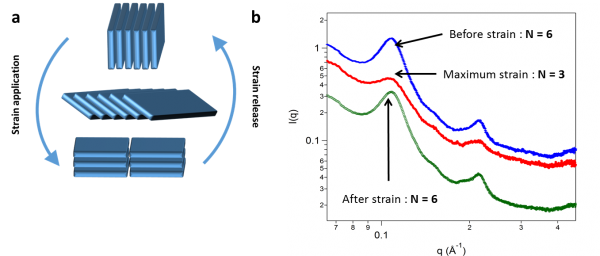A very promising strategy for obtaining new materials consists in dispersing nanoparticles with interesting properties within a medium that is easy to shape and manipulate; in such nanocomposites, the main difficulty is controlling the aggregation state of the particles, as well as their position and orientation. Researchers from the Laboratoire de Physique des Solides (Orsay) and the SWING beamline have just shown that all these parameters can be reversibly tuned by a stretching deformation: it is possible to control reversibly the orientation and stacking state of nanoplatelets confined within a polymer matrix, simply by pulling on the material.
The nanocomposite employed consists in a matrix of polymer chains with alternating composition (polystyrene ─ polybutadiene ─ polystyrene) doped with fluorescent CdSe platelets, eight atoms thick and fifteen times as wide. The platelets assemble spontaneously in stacks, confined in the polybutadiene domains (Figure 1a). Using a traction device, the material is submitted to controlled strain, while being exposed to the strong X-ray beam produced by the SWING beamline (Figure 1b). The scattering pattern thus recorded provides information on the evolution of the lamellar micro-structure and of the platelet stacks.

Figure 1: a) Electron microscopy image of the composite system. The scale bar is 50 nm. In the inset, a few platelet stacks (zoom x3). Illustration taken from Beaudoin et al., Chem. Commun. 51, 4051 (2015). b) Diagram of the experimental setup used in the work described here.
In agreement with literature results on these systems, one detects a reorientation of the lamellar domains under strain. The surprising result is that this motion destabilizes the platelet stacks, shears them and tilt them on the side, as if cutting a deck of cards in two smaller ones (Figure 2a). The evolution is reversible, since after releasing the stress the stacks return to their initial size and orientation (Figure 2b). Moreover, the process can be inhibited by reinforcing the interaction between platelets in the stack using excess oleic acid, the molecule that renders them compatible with the matrix.

Figure 2: a) Evolution of a platelet stack under strain: the initial pack is sheared and split into two smaller packs, perpendicular to the initial orientation. b) This transformation is reversible: the number of platelets (measured from the X-ray scattering patterns) returns to its initial once the stress is released.
This discovery raises fundamental questions concerning the interaction of nano-objects with their environment, but it also suggests new ways of formulating and processing composite materials with original properties.
